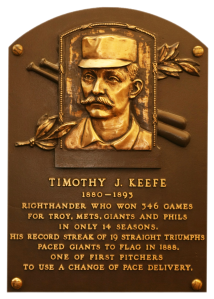
Year Inducted: 1936 (BBWAA, ballot #1, 205/226)
Score: 33541
Who was the best World Series pitcher ever? Several players would seem to have a claim to that title. Don Larsen had a perfect game in 1956, Jack Morris had his masterpiece in 1991, and Whitey Ford had lots of World Series wins for his Yankees. Yet, none of them had the best single World Series. In the second ever World Series in 1905, the New York Giants were pitted against the Philadelphia A’s with four of the best pitchers of all-time slated to pitch. The A’s put their hopes on the arms of Chief Bender and Eddie Plank, but they mustered a total of three runs. All three of those runs came in Game 2 against Joe McGinnity, who would win the crucial Game 4 for the Giants. In Games 1, 3 and 5 the A’s were stymied by one of the best right handers of all-time, Christy Mathewson.








